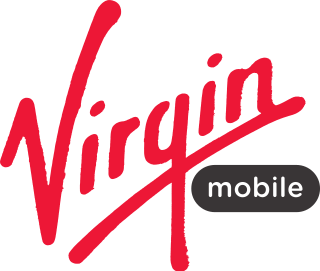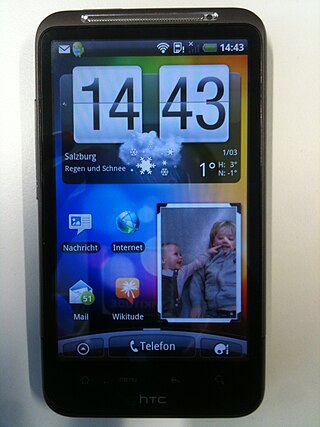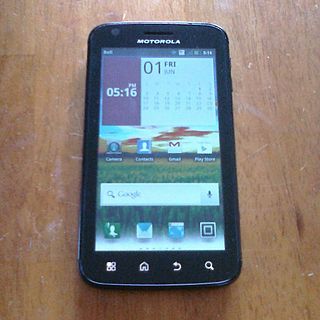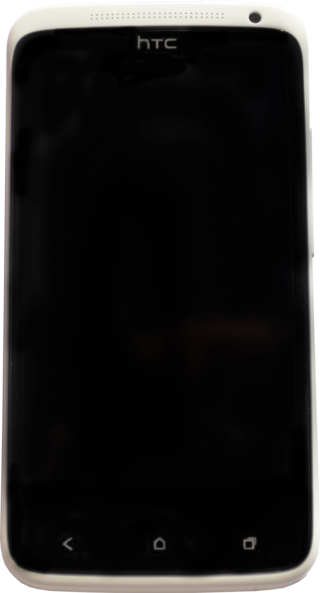
Virgin Mobile USA was a no-contract Mobile Virtual Network Operator. It used Sprint's network for coverage. It licensed the Virgin Mobile brand from United Kingdom-based Virgin Group. Virgin Mobile USA was headquartered in Kansas City, Missouri, and provided service to approximately 6 million customers.

HTC Hero is the third phone manufactured by HTC running the Android platform, announced on June 24, 2009 in London.

HTC Sense is a software suite developed by HTC, used primarily on the company's Android-based devices. Serving as a successor to HTC's TouchFLO 3D software for Windows Mobile, Sense modifies many aspects of the Android user experience, incorporating additional features, additional widgets, re-designed applications, and additional HTC-developed applications. The first device with Sense, the HTC Hero, was released in 2009. The HD2 running Windows Mobile 6.5, released later the same year, included Sense. Following the release of the Hero, all future Android devices by HTC were shipped with Sense, except for the Nexus One, the Desire Z, the HTC First, the Google Pixel and Pixel 2, and the Nexus 9 which used a stock version of Android. Also some HTC smartphones that are using MediaTek processors come without HTC Sense.

HTC is the original design manufacturer for many Android and Windows Phone-based smartphones and PDAs. Brands that market or previously marketed HTC-manufactured products include Dell, Fujitsu Siemens, HP/Compaq, i-mate, Krome, O2, Palm, Sharp Corporation, and UTStarcom. HTC also manufactures ultra-mobile PCs, and is also the manufacturer of the Nexus One and Nexus 9, a smartphone and tablet designed and branded by Google, respectively.

The HTC Evo 4G is a smartphone developed by HTC Corporation and marketed as Sprint's flagship Android smartphone, running on its WiMAX network. The smartphone was launched on June 4, 2010. It was the first 4G enabled smartphone released in the United States.

The HTC Desire HD is an Android smartphone by HTC Corporation. It was unveiled at a press event in London hosted by HTC on September 15, 2010, and was made available for sale in October in Europe and in January 2011 in Canada. The Desire was HTC's fourth flagship Android device until the release of their new line of flagship model, the HTC Sensation.

The Motorola Atrix 4G is an Android-based smartphone developed by Motorola, introduced at CES 2011 along with the Motorola Xoom, Motorola Droid Bionic, and Motorola Cliq 2 on January 5, 2011. It was made available in the first quarter of 2011.
The HTC Evo Shift 4G is a smartphone developed by HTC Corporation and marketed as the concurrent/sequel to Sprint's flagship Android smartphone, running on its 4G WiMAX network. The smartphone launched on January 9, 2011.

The HTC Evo 3D is a 3D-enabled Android smartphone developed by HTC, released exclusively in the United States through Sprint, and was re-released as a pre-paid smartphone by Virgin Mobile in May 2012 as the HTC Evo V 4G. A variation of Sprint's flagship HTC Evo 4G, the device is distinguished by its pair of 5 MP rear cameras, which made the Evo 3D the first cell phone to do so, which can be used to take photos or video in stereographic 3D, which can be viewed on its autostereoscopic display without the need for 3D glasses. Several GSM variants are also available in Canada, Europe and Asia.

The HTC Sensation is a smartphone designed and manufactured by HTC Corporation that runs the Android 2.3 Gingerbread software stock. Officially announced by HTC on April 12, 2011, the HTC Sensation was launched by Vodafone in key European markets including the United Kingdom on May 19, 2011 and by T-Mobile in the United States on June 12, 2011. It was HTC's fifth flagship Android phone and the first HTC phone to support the HTC Sense 3.0 user interface. At the time of its release, the Sensation XE was the world's fastest Android phone.

The LG Optimus 3D is a 3D-enabled Android 2.2 Froyo 3D mobile device released on 7 July 2011 in the UK and advertised as the world's first full 3D mobile phone. It has 512 MB of RAM and 8 GB of onboard storage, which can be expanded by up to 32 GB using a micro SDHC card. The phone features two 5 MP back-facing cameras that are capable of filming 720p 3D and Full HD 1080p in 2D, while pictures taken in 2D mode are 5 MP and 3 MP when taking a 3D picture. It also includes a VGA front-facing camera for video-calling. The phone features a 3D user interface which allows the users to access 3D content, such as YouTube in 3D, 3D games and apps, or 3D gallery with a push of a button.
The HTC Ruby is a smartphone developed by the HTC Corporation. It was released by T-Mobile in the United States on 10 October 2011. It was first released in Canada by Telus on 4 November 2011. Subsequently, other Canadian carriers such as Mobilicity and Wind Mobile released this phone on December 1, 2011 and December 2 ,2011, respectively. Marketed at the time as being equipped “with the most advanced camera of any smartphone”, the device has an 8-megapixel camera, a 1080p HD video recorder, a backside illuminated sensor, and a dual LED flash. The Amaze 4G features a Qualcomm Snapdragon S3 1.5 Gdual-corporate processor, a 4.3-inch QHD LCD multi-touch display, and 1 GB of RAM. It was released with version 2.3.4 of the Android operating system. Starting from 21 May 2012, some HTC Amaze devices were upgradeable to Android 4.0.3 Ice Cream Sandwich.

The HTC One X is a touchscreen-based, slate-sized smartphone designed and manufactured by HTC. It was released running Android 4.0.3, with the HTC Sense 4.0 skin. The One X is powered by the NVIDIA Tegra 3 for most international GSM carriers, making this the first HTC phone to be equipped with a quad-core processor, while a variant which is LTE capable is powered by the Qualcomm Snapdragon S4 dual-core 1.5 GHz Krait processor. The One X was announced on February 26, 2012, at the Mobile World Congress and was HTC's sixth flagship product, leading the HTC One series from the time of its release through April 2013, when its successor the HTC One (M7) was announced.

The HTC One S is a premium smartphone designed and manufactured by HTC as part of the HTC One series which has Beats Audio and runs the Android 4.0 "Ice Cream Sandwich" mobile operating system with HTC Sense. Announced by HTC on 26 February 2012, the HTC One S was scheduled for official release on 2 April 2012. The first phones were sold on March 30. In the United States, the One S is carried by T-Mobile and Solavei.

The HTC Evo 4G LTE is an Android smartphone developed by HTC Corporation to be released exclusively by Sprint. A successor to the previous HTC Evo 4G and 3D models, the Evo 4G LTE supports Sprint's LTE cellular network and its current-generation EV-DO network. The Evo 4G LTE shares features with its GSM counterpart, the HTC One X—such as the same dual-core 1.5 GHz processor used by the One X's LTE variant, a 4.7-inch screen, and Android 4.1 with HTC's Sense 4.0 interface. The Evo 4G LTE was also the first phone built with an all aluminum frame, leaving only a small plastic piece to allow the Sim and micro sd cards to be installed.
HTC One is a series of Android and Windows Phone smartphones designed and manufactured by HTC. All products in the One series were designed to be touchscreen-based and slate-sized, and to initially run the Android mobile operating system with the HTC Sense graphical user interface. The one exception to this is the HTC One (M8), which also had a Windows Phone variant. From 2010 to 2013, all HTC products starting from the HTC Sensation XE to the HTC One Mini were equipped with a Beats Audio equalizer. Later HTC devices beginning with the HTC One Max no longer ship with Beats Audio following the buyback of HTC's stake in Beats Electronics.
The Droid Incredible 4G LTE, also known as the HTC Incredible 4G or Incredible 3, is a smartphone designed and manufactured by Taiwan's HTC Corporation that runs the Android 4.0 operating system (ICS). Officially announced by Verizon on May 7, 2012, for CTIA, and released on July 5, 2012, through Verizon Wireless for $149.99 with a new two-year contract. The Droid Incredible 4G LTE is the successor to the HTC Incredible S.

The Droid Razr M is an Android-based, 4G LTE-capable smartphone designed by Motorola as a smaller successor to the Droid Razr. It was advertised as "The full screen phone" with thin edges, though it lacked a robust resolution. It came with a light skin of Android for Verizon Wireless (XT907), SoftBank Mobile (XT902), and Telstra as well as an unbranded retail version for the Australian market. The Electrify M (XT901) for U.S. Cellular is a CDMA handheld with a different housing, but otherwise same specification as the Razr M.

HTC One is a touchscreen-based Android smartphone designed, developed, and manufactured by HTC. The smartphone was unveiled on 19 February 2013 at press events in New York City and London and is HTC's seventh flagship smartphone. It has been hailed by many as a revolutionary Android handset with its premium design and build quality and its emphasis on high end audio. It is the successor to the company's 2012 flagship model, the One X—which was critically acclaimed, but commercially unsuccessful due in part to insufficient marketing efforts. To make the device stand out among its competition, HTC One was developed with a major emphasis on unique hardware and software features; which included a unibody aluminum frame, a 1080p full-HD display, dual front-facing stereo speakers, a camera with a custom image sensor and the ability to automatically generate montages of media, an updated version of HTC's Sense user experience, BlinkFeed—an aggregator of news and social network content, and an electronic program guide app with the ability to serve as a universal remote via an IR blaster located in the device's power button.
Boost Mobile is an American wireless service provider owned by Dish Wireless. It uses the Dish, AT&T and T-Mobile networks to deliver wireless services. As of Q3 2023, Boost Mobile, along with its sister brands Boost Infinite, Gen Mobile, and Ting Mobile had 7.50 million customers.














